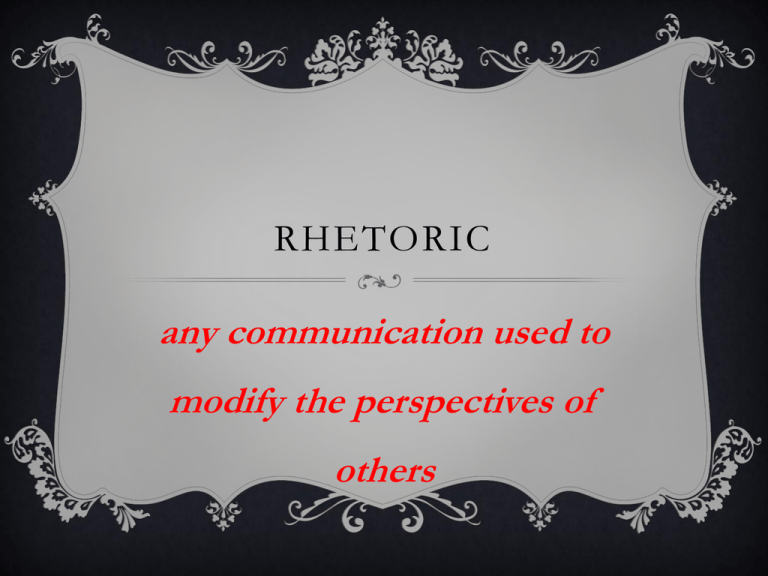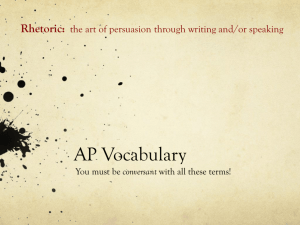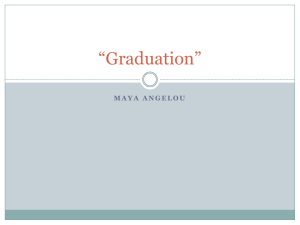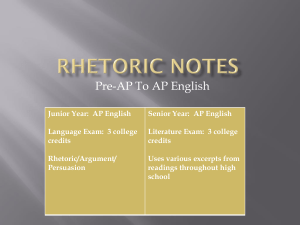Rhetoric
advertisement

RHETORIC any communication used to modify the perspectives of others RHETORICAL SITUATION The circumstances in which you communicate THE RHETORICAL SITUATION THE WRITER Your culture, personal characteristics affect what you write about and how you write it. P U R P O S E : YO U R R E A S O N F O R WRITING AU D I E N C E : T O W H O M A R E YO U WRITING? Many of the same factors which affect the writer also affect the audience • Social class • Education • Culture • Political beliefs CONTEXT The “situation” which generates the need for writing Affected by the • • • • Time period or timing Location Current events Cultural significance THE RHETORICAL TRIANGLE Audience Rhetorical (Pathos) Context Speaker/ Writer: Ethos Message (Logos) ETHOS • Refers to the writer or speaker • appeal based on the character of the speaker • An ethos-driven document relies on the reputation of the author. ETHOS EXAMPLE "As a doctor, I am qualified to tell you that this course of treatment will likely generate the best results. LOGOS: • Logic (Rational Thought) added to the argument • Refers to human reasoning • Used to “prove” your opinion/message • Example: LOGOS EXAMPLE Notably, since stabilizing in mid-2009, real household spending in the United States has grown in the range of 1 to 2 percent at annual rates, a relatively modest pace. LOGOS ELEMENTS • Assumption: underlying belief • Counterargument: way to appeal to logos is to anticipate other views • When you CONCEDE the opposing argument MIGHT be true, you have the ability to RUFUTE (deny) their validity. Lou clip PATHOS • appeal based on emotion. • 'appeal to the audience's sympathies and imagination.' • Language choice affects the audience's emotional response • An appeal to pathos causes an audience not just to respond emotionally but to identify with the writer's point of view--to feel what the writer feels • the power with which the writer's message moves the audience to decision or action. PATHOS EXAMPLE Some of you have come from areas where your quest -- quest for freedom left you battered by the storms of persecution and staggered by the winds of police brutality. r RHETORICAL DEVICES RHETORICAL DEVICES Rhetorical question: is a figure of speech in the form of a question that is asked in order to make a point The question is not to elicit a specific answer, but to get the listener to consider a viewpoint Persuade an audience to believe in the position(s) of the speaker. • What have the Romans ever done for us? REPETITION The simple repeating of a word, within a sentence or a poetical line, with no particular placement of the words, in order to secure emphasis. • Antanaclasis is the repetition of a word or phrase to effect a different meaning • "We must all hang together, or assuredly we shall all hang separately." (Benjamin Franklin) TYPES OF REPETITION Anaphora is the repetition of a word or phrase at the beginning of every clause. It comes from the Greek phrase, "Carrying up or Back". • "We shall fight on the beaches, we shall fight on the landing grounds, we shall fight in the fields and in the streets, we shall fight in the hills, we shall never surrender." (Winston Churchill) ANALOGIES A kind of extended metaphor or long simile in which an explicit comparison is made between two things (events, ideas, people, etc.) for the purpose of furthering a line of reasoning or drawing an inference • Example: "Withdrawal of U.S. troops will become like salted peanuts to the American public; the more U.S. troops come home, the more will be demanded." ANALOGY VS. SIMILE While simile and analogy often overlap, the simile is generally a more artistic likening, done briefly for effect and emphasis, while analogy serves the more practical end of explaining a thought process or a line of reasoning or the abstract in terms of the concrete, and may therefore be more extended. PARALLELISM (GRAMMAR) Parallel structure means that two or more ideas in a sentence are expressed in similar form. And, but and or usually join similar • I am neither a Catholic nor a Protestant. • Nancy read a book while Joe watched television. • We are giving away our furniture, selling our house and moving to Spain PARALLELISM (VERBS AND ADVERBS) I have always sought but seldom obtained a parking space near the door. Quickly and happily he walked around the corner to buy the book. PARALLELISM (VERBS AND OBJECTS) He liked to eat watermelon and to avoid grapefruit This wealthy car collector owns three pastel Cadillacs, two gold Rolls Royces, and ten assorted Mercedes PARALLELISM (PHRASES) The pilot walked down the aisle, through the door, and into the cockpit He left the engine on, idling erratically and heating rapidly. To think accurately and to write precisely are interrelated goals PARALLELISM (RHETORIC) is recurrent syntactical similarity. Several parts of a sentence or several sentences are expressed similarly to show that the ideas in the parts or sentences are equal in importance. Parallelism also adds balance and rhythm and, most importantly, clarity. PARALLELISM (RHETORIC "Let every nation know, whether it wishes us well or ill, that we shall pay any price, bear any burden, meet any hardship, support any friend, oppose any foe to assure the survival and the success of liberty." — John F. Kennedy We beg no longer. We entreat no more. We petition no more. We defy them." — William Jennings Bryan UNDERSTATEMENT AND HYPERBOLE Understatement: deliberately expresses an idea as less important than it actually is, either for ironic emphasis or for politeness and tact. • Last week I saw a woman flayed, and you will hardly believe how much it altered her person for the worse. --Jonathan Swift Hyperbole: the counterpart of understatement, deliberately exaggerates conditions for emphasis or effect. • I've seen cows hurt worse than this get up and get well METAPHOR Metaphor compares two different things by speaking of one in terms of the other. Unlike a simile or analogy, metaphor asserts that one thing is another thing, not just that one is like another. Very frequently a metaphor is invoked by the to be verb • affliction then is ours; / We are the trees whom shaking fastens more. --George Herbert • When it comes to midterms, it's kill or be killed. Let's go in and slay this test ALLITERATION is the recurrence of initial consonant sounds. • Done well, alliteration is a satisfying sensation • I shall delight to hear the ocean roar, or see the stars twinkle, in the company of men to whom Nature does not spread her volumes or utter her voice in vain. --Samuel Johnson PARADOX is a statement that apparently contradicts itself and yet might be true. • "This statement is false", a form of the liar paradox. The statement is referring to itself. often refers to statements that are ironic or unexpected, such as • "the paradox that standing is more tiring than walking" OXYMORON is a paradox reduced to two words, usually in an adjective-noun or adverb-adjective • eloquent silence • inertly strong is used for effect, complexity, emphasis, or wit • He was now ready to order a party of modest magnificence OXYMORON CONTINUED An oxymoron shows the complexity of a situation where two apparently opposite things are true simultaneously, • literally ("desirable calamity") • imaginatively ("love precipitates delay“ An oxymoron can be useful when things have gone contrary to expectation, belief, desire, or assertion, or when your position is opposite to another's which you are discussing. • The cost-saving program became an expensive economy JUXTAPOSITION an act or instance of placing close t o each other or side-by-side, especially for comparison and contrast • Peasants and aristocrats; • Forget to remember or remember to forget." ANTITHESIS establishes a clear, contrasting relationship between two ideas by joining them together or juxtaposing them, often in parallel structure. • To err is human; to forgive, divine. –Pop Antithesis can convey some sense of complexity in a person or idea by admitting opposite or nearly opposite truths: • Success makes men proud; failure makes them wise. REFERENCES: • Crewell, D. (1999) The Art of Rhetoric. http://www.rpi.edu/dept/llc/webclass/web/project1/group4 / • http://courses.durhamtech.edu/perkins/aris.html • Rozkelly, H. (1998) Everyday use: Rhetoric at work in reading and writing. New Your, NY: Pearson





